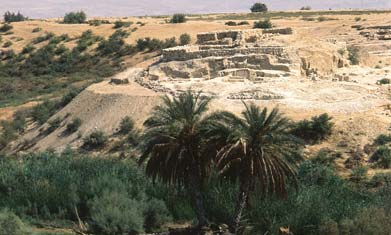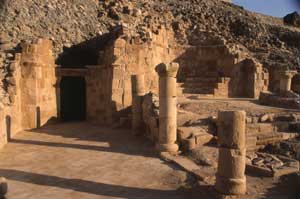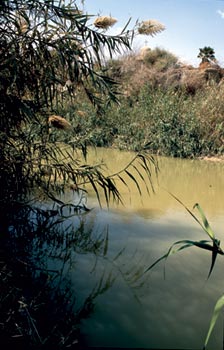|
|
|
|
|
|
|
|
|
|
Meandering through the Jordan valley is the River Jordan, a scared stream of numerous symbols and historical events. The Prophets Joshua, Elijah, Elisha, John the Baptist and Jesus Christ all crossed it during their lifetimes. The area alongside the river associated with their deeds, just 45 minutes by car from Madaba via Mount Nebo, is easily accessible to visitors once again.
Entrance fees is JD 8 including guiding tour.
Working hours from 7:00 am to 6:00 pm summer time and winter time up to 4:00 pm.
|
Joshuas miraculous crossing of the river Jordan into Canaan after Moses death (Numers 13: 14-16) reportedly took place at the ford in the river directly opposite Jericho, long known as Bethabara or Beit Abarah (house of the cossing).
The large loop in the Jordan River opposite has long been identified as the spot where Jesus Christ was baptised by John the Baptist. It is called al-Maghtas in Arabic. Less than two kilometers east of the river is another important place associated with the lives of Jesus and john the Baptistط·آ·ط¢آ£ط·آ¢ط¢آ¢ط·آ£ط¢آ¢ط£آ¢أ¢â€ڑآ¬ط¢ع‘ط·آ¢ط¢آ¬ط·آ£ط¢آ¢ط£آ¢أ¢â‚¬ع‘ط¢آ¬ط£آ¢أ¢â€ڑآ¬ط¥â€™the settlement of Bethany, where John lived and baptized . John 1:28 refers to it as "Bethany beyond the Jordan, where John was baptizing". In John 10:40 it is mentioned as the place to which Jesus fled for safety after being threatened with stoning in Jerusalem: (Then Jesus went back across the Jordan to place where John had been baptizing in the early days.)ط·آ£ط¢آ¢ط£آ¢أ¢â‚¬ع‘ط¢آ¬ط·آ¥أ¢â‚¬â„¢
|
 |
This settlement of Bethany has recently been identified on the south bank of the small perennial stream named Wadi Kharrar, just east of the Jordan River and opposite Jericho. It is being excavated, protected, and made accessible to visitors. The small natural hill forming the core of Bethany is called Elijah's Hill, or Tell Mar Eliasin Arabic. Local tradition for thousands of years has identified it as the place from where Elijah ascended to haven. Bethany's ancient remains include structures from the 1st Century AD settlement of John the Baptist, including large plastered pools with steps for full immersion. The 5th-6th Century AD remains at Bethany are those of the Byzantine period settlement, also called Ainon or Saphsaphas and depicted on the 6th Century Madaba mosaic map of the holy land.
|
 |
When Jesus spent 40 days in the wilderness after his baptism (Mark 1:12), he may well have been in the stark, desolate marl area immediately east of the Jordan River and north of the Bethany. He spread his message throughout Transjordan on several different occasions, including during his last journey from Galilee to Jerusalem (Matthew 19).
|
 |
The wide plain at the Jordan River Valley's southern end, around the north-east Dead Sea coast, was called the Plains of Moad in the Bible, and was where Joshua and his people camped before crossing to Canaan (Joshua 3:1). At Abel-Shittim, modern Tell Hammam in the Plains of Moab, Joshua was designated as Moses successor (Numbers 27:23; Joshua 2:1). Nearby and recently excavated Tell Nimrin was Beth-Nimrah, a fortified city of the tribe of Gad (Numbers 32:36). The Wadi Nimrin riverbed is likely the biblical Waters of Nimrim, which once dried up in antiquity (Isaiah 15:6; Jeremiah 48:34).
|
|
|
|
|
|
|
|
|
|
|
|
|
|
|
|
|
|
|
|